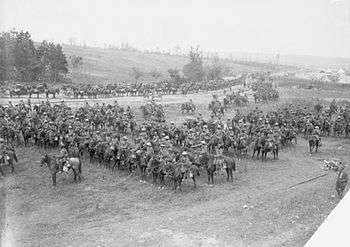9th Deccan Horse
| 9th Deccan Horse | |
|---|---|
| Active | 1790–present |
| Country |
|
| Branch | British Indian Army |
| Type | Cavalry |
| Size | Regiment |
| Part of | Indian Cavalry Corps |
| Nickname(s) | Deccan Horse |
| Equipment | Horse |
| Engagements |
Second Afghan War-1879-1880 Burma War-1886-1888 China-1900 |
| Battle honours |
Central India Battle of Givenchy Battle of the Somme Battle of Bazentin Battle of Delville Wood Battle of Flers–Courcelette Battle of Cambrai France and Flanders 1914–18 Battle of Megiddo Battle of Sharon Capture of Damascus Palestine 1918 Battle of Meiktilla Rangoon Road Burma Campaign 1944–45 |
The 9th Deccan Horse is a regiment of the Indian Army, which was a regular cavalry regiment of the British Indian Army, the Royal Deccan Horse (9th Horse). It was formed from the amalgamation of two regiments after World War I. They saw service from the Mutiny of 1857 up to and including World War II.
Formation
The 9th Royal Deccan Horse can trace its formation to 1790 when it was called Asif Sah's Irregular Cavalry. Two Regiments were raised for service under the Nizam of Hyderabad in Berar who was allied with the East India Company.[1]
During the following years the Regiment's title would change and they were known by the following titles over the years;
- 1st Regiment, Nizam’s Cavalry
- 2nd Regiment, Nizam's Cavalry
- 1st Cavalry, Hyderabad Contingent
- 2nd Cavalry, Hyderabad Contingent
- 1st Lancers, Hyderabad Contingent
- 2nd Lancers, Hyderabad Contingent.[1]
The Deccan Horse was frequently called for service during the 18th and 19th Centuries, winning a Victoria Cross in 1859 and was also awarded the battle honour, ‘Central India’.[1]
The Regiment was also in action during the Second Afghan War, the Burma War, and in China during the Boxer Rebellion. In 1903 during Kitcheners reform of the Indian Army the two Regiments were incorporated into the regular Indian Army with the titles XXth Deccan Horse and the 29th Lancers (Deccan Horse).[1]

World War I
The 20th Deccan Horse was sent to France for service on the Western Front they were part of the 9th (Secunderabad) Cavalry Brigade of the 2nd Indian Cavalry Division.[2] This regiment also served in Palestine and Syria during the Battle of Megiddo forming part of the 14th Cavalry Brigade, 5th Cavalry Division.[3]
The 29th Lancers were also sent to France they formed part of the 8th (Lucknow) Cavalry Brigade of the 1st Indian Cavalry Division.[2]
Both Regiments would at times serve as Infantry in the trenches before being withdrawn for service in Palestine.[1]
Amalgamation

The XXth Deccan Horse was awarded the titled Royal for their distinguished service during World War I, and in 1922 following the amalgamation of the two regiments, the Royal Deccan Horse (9th Horse) was formed.[1]
World War II
During the Second World War, the Regiment converted to tanks, and became part of the 255th Indian Tank Brigade[4] The regiment took part in the re-conquest of Burma.
Awards & Honours
Victoria Cross
Risaldar Badlu Singh, 14th Murray's Jat Lancers attached to the 29th Lancers, on 23 September 1918 at Kh. es Samariyeh, Jordan River, Palestine.
Citation: Risaldar Badlu Singh was attached to 29th Lancers when "on the morning of the 23rd September 1918, his squadron charged a strong enemy position on the west bank of the river Jordan, between the river and Kh. es Samariyeh village. "On nearing the position, Risaldar Badlu Singh realised that the squadron was suffering casualties from a small hill on the left front occupied by machine guns and 200 infantry. Without the slightest hesitation he collected six other ranks and with the greatest dash and total disregard for danger, charged and captured the position, thereby saving very heavy casualties to the squadron. He was mortally wounded on the very top of the hill when capturing one of the machine guns single handed, but all the machine guns and infantry had surrendered to him before he died. "His valour and initiative were of the highest order." [5]
Konsal Singh
- Description Medal card of Konsal Singh *[6]
- 20th Deccan Horse – Risaldar
- Date – 1914–1920
Honorary Capt. Jailal Singh, Military Cross: The Royal Deccan Horse Vill. Girdharpur(Babepur) Jhajjar Haryana
Shaik Fayaz Uddin
- Indian Distinguished Service Medal.
- Rank: Risaldar Major,aide-de-camp to the Viceroy of India, Lord Irwin
- Fought bravely during World War I against the Germans at Givenchy,[7] and because of his bravery he was awarded the post of Risaldar.
References
- 1 2 3 4 5 6 "geocities". Archived from the original on 23 October 2009.
- 1 2 "cwgc.org". Archived from the original on 14 September 2012.
- ↑ Falls, Cyril; A. F. Becke (maps) (1930). Military Operations Egypt & Palestine from June 1917 to the End of the War. Official History of the Great War Based on Official Documents by Direction of the Historical Section of the Committee of Imperial Defence. 2 Part II. London: HM Stationery Office. OCLC 256950972. p. 667
- ↑ "wewerethere".
- ↑ London Gazette, 27 November 1918
- ↑ Record Number WO 372/11 at http://www.nationalarchives.gov.uk
- ↑ Royal Deccan Horse book